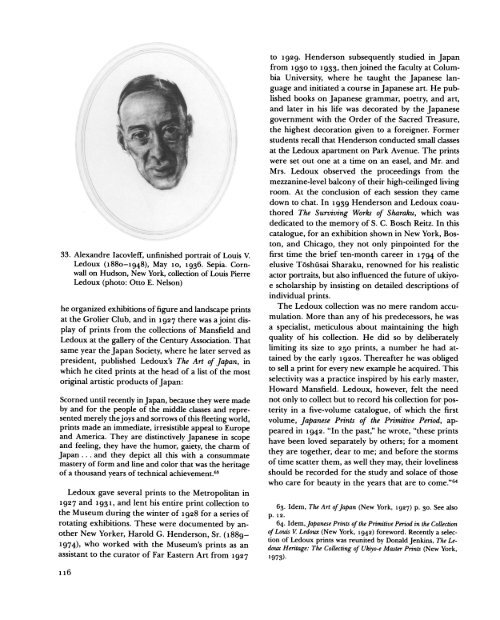Early Collectors of Japanese Prints and The Metropolitan Museulm ...
Early Collectors of Japanese Prints and The Metropolitan Museulm ...
Early Collectors of Japanese Prints and The Metropolitan Museulm ...
Create successful ePaper yourself
Turn your PDF publications into a flip-book with our unique Google optimized e-Paper software.
33. Alex<strong>and</strong>re Iacovleff, unfinished portrait <strong>of</strong> Louis V.<br />
Ledoux (1880-1948), May lo, 1936. Sepia. Corn-<br />
wall on Hudson, New York, collection <strong>of</strong> Louis Pierre<br />
Ledoux (photo: Otto E. Nelson)<br />
he organized exhibitions <strong>of</strong> figure <strong>and</strong> l<strong>and</strong>scape prints<br />
at the Grolier Club, <strong>and</strong> in 1927 there was ajoint dis-<br />
play <strong>of</strong> prints from the collections <strong>of</strong> Mansfield <strong>and</strong><br />
Ledoux at the gallery <strong>of</strong> the Century Association. That<br />
same year the Japan Society, where he later served as<br />
president, published Ledoux's <strong>The</strong> Art <strong>of</strong> Japan, in<br />
which he cited prints at the head <strong>of</strong> a list <strong>of</strong> the most<br />
original artistic products <strong>of</strong> Japan:<br />
Scorned until recently in Japan, because they were made<br />
by <strong>and</strong> for the people <strong>of</strong> the middle classes <strong>and</strong> repre-<br />
sented merely the joys <strong>and</strong> sorrows <strong>of</strong> this fleeting world,<br />
prints made an immediate, irresistible appeal to Europe<br />
<strong>and</strong> America. <strong>The</strong>y are distinctively <strong>Japanese</strong> in scope<br />
<strong>and</strong> feeling, they have the humor, gaiety, the charm <strong>of</strong><br />
Japan... <strong>and</strong> they depict all this with a consummate<br />
mastery <strong>of</strong> form <strong>and</strong> line <strong>and</strong> color that was the heritage<br />
<strong>of</strong> a thous<strong>and</strong> years <strong>of</strong> technical achievement.63<br />
Ledoux gave several prints to the <strong>Metropolitan</strong> in<br />
1927 <strong>and</strong> 1931, <strong>and</strong> lent his entire print collection to<br />
the Museum during the winter <strong>of</strong> 1928 for a series <strong>of</strong><br />
rotating exhibitions. <strong>The</strong>se were documented by an-<br />
other New Yorker, Harold G. Henderson, Sr. (1889-<br />
1974), who worked with the Museum's prints as an<br />
assistant to the curator <strong>of</strong> Far Eastern Art from 1927<br />
116<br />
to 1929. Henderson subsequently studied in Japan<br />
from 1930 to 1933, then joined the faculty at Colum-<br />
bia University, where he taught the <strong>Japanese</strong> lan-<br />
guage <strong>and</strong> initiated a course in <strong>Japanese</strong> art. He pub-<br />
lished books on <strong>Japanese</strong> grammar, poetry, <strong>and</strong> art,<br />
<strong>and</strong> later in his life was decorated by the <strong>Japanese</strong><br />
government with the Order <strong>of</strong> the Sacred Treasure,<br />
the highest decoration given to a foreigner. Former<br />
students recall that Henderson conducted small classes<br />
at the Ledoux apartment on Park Avenue. <strong>The</strong> prints<br />
were set out one at a time on an easel, <strong>and</strong> Mr. <strong>and</strong><br />
Mrs. Ledoux observed the proceedings from the<br />
mezzanine-level balcony <strong>of</strong> their high-ceilinged living<br />
room. At the conclusion <strong>of</strong> each session they came<br />
down to chat. In 1939 Henderson <strong>and</strong> Ledoux coau-<br />
thored <strong>The</strong> Surviving Works <strong>of</strong> Sharaku, which was<br />
dedicated to the memory <strong>of</strong> S. C. Bosch Reitz. In this<br />
catalogue, for an exhibition shown in New York, Bos-<br />
ton, <strong>and</strong> Chicago, they not only pinpointed for the<br />
first time the brief ten-month career in 1794 <strong>of</strong> the<br />
elusive Toshuisai Sharaku, renowned for his realistic<br />
actor portraits, but also influenced the future <strong>of</strong> ukiyo-<br />
e scholarship by insisting on detailed descriptions <strong>of</strong><br />
individual prints.<br />
<strong>The</strong> Ledoux collection was no mere r<strong>and</strong>om accu-<br />
mulation. More than any <strong>of</strong> his predecessors, he was<br />
a specialist, meticulous about maintaining the high<br />
quality <strong>of</strong> his collection. He did so by deliberately<br />
limiting its size to 250 prints, a number he had at-<br />
tained by the early 192os. <strong>The</strong>reafter he was obliged<br />
to sell a print for every new example he acquired. This<br />
selectivity was a practice inspired by his early master,<br />
Howard Mansfield. Ledoux, however, felt the need<br />
not only to collect but to record his collection for pos-<br />
terity in a five-volume catalogue, <strong>of</strong> which the first<br />
volume, <strong>Japanese</strong> <strong>Prints</strong> <strong>of</strong> the Primitive Period, ap-<br />
peared in 1942. "In the past," he wrote, "these prints<br />
have been loved separately by others; for a moment<br />
they are together, dear to me; <strong>and</strong> before the storms<br />
<strong>of</strong> time scatter them, as well they may, their loveliness<br />
should be recorded for the study <strong>and</strong> solace <strong>of</strong> those<br />
who care for beauty in the years that are to come."64<br />
63. Idem, <strong>The</strong> Art <strong>of</strong> Japan (New York, 1927) p. 30. See also<br />
p. 12.<br />
64. Idem, <strong>Japanese</strong> <strong>Prints</strong> <strong>of</strong> the Primitive Period in the Collection<br />
<strong>of</strong> Louis V Ledoux (New York, 1942) foreword. Recently a selec-<br />
tion <strong>of</strong> Ledoux prints was reunited by Donald Jenkins, <strong>The</strong> Le-<br />
doux Heritage: <strong>The</strong> Collecting <strong>of</strong> Ukiyo-e Master <strong>Prints</strong> (New York,<br />
1973).

















